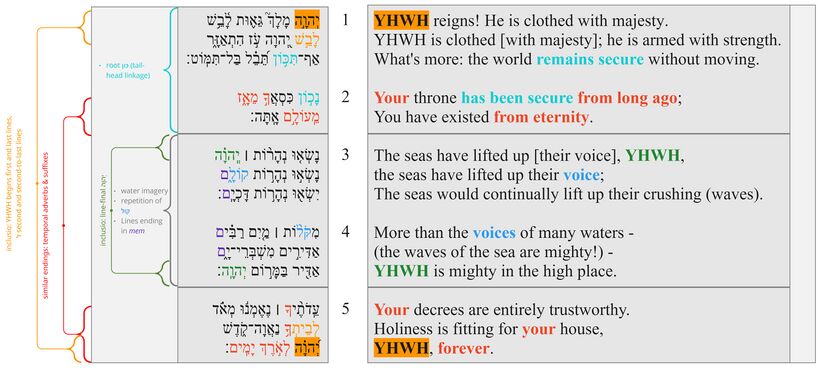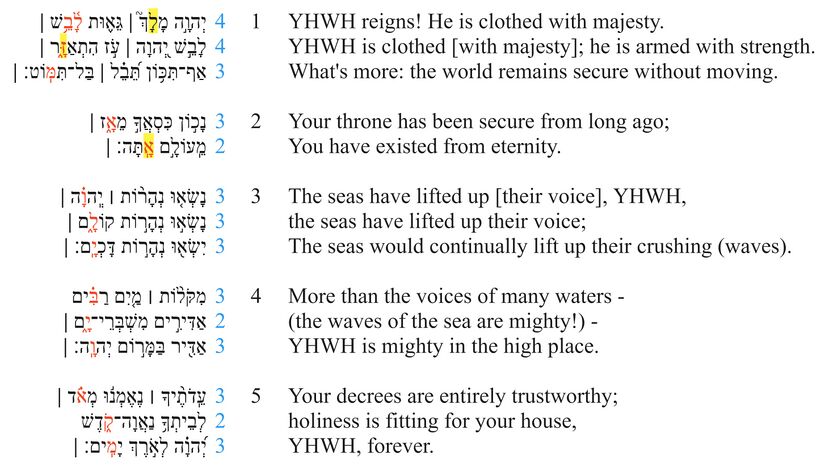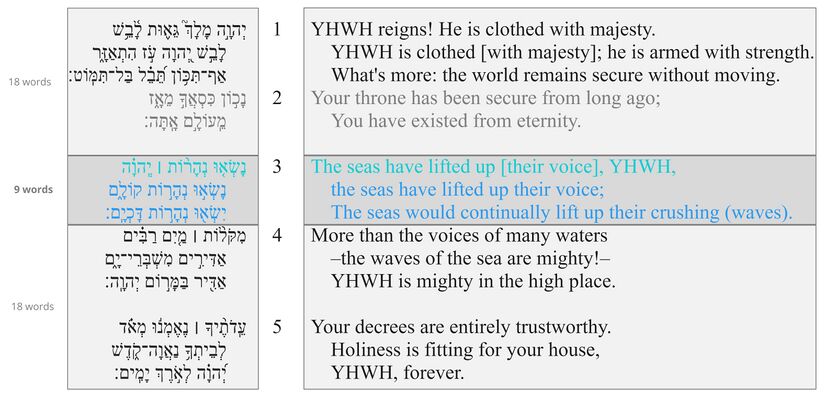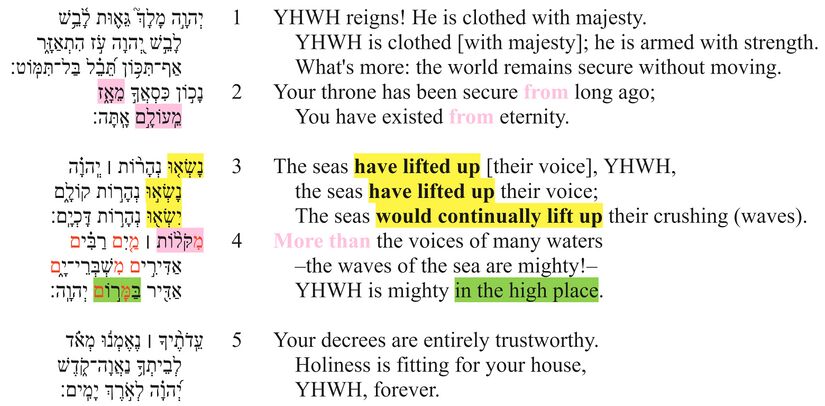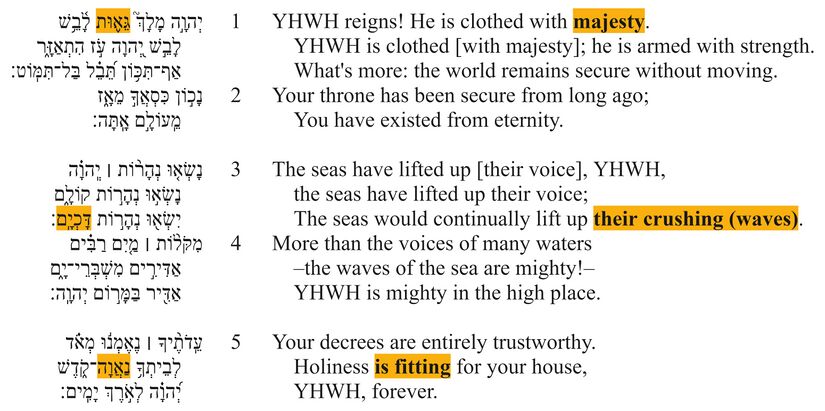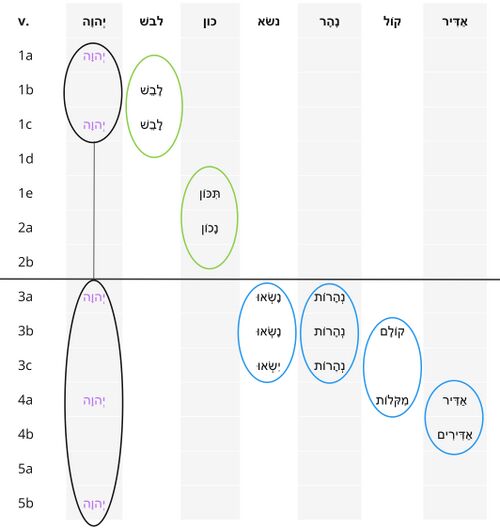Psalm 93 Poetics
About the Poetics Layer
Exploring the Psalms as poetry is crucial for understanding and experiencing the psalms and thus for faithfully translating them into another language. This layer is comprised of two main parts: poetic structure and poetic features. (For more information, click 'Expand' to the right.)
Poetic Structure
In poetic structure, we analyse the structure of the psalm beginning at the most basic level of the structure: the line (also known as the “colon” or “hemistich”). Then, based on the perception of patterned similarities (and on the assumption that the whole psalm is structured hierarchically), we argue for the grouping of lines into verses, verses into sub-sections, sub-sections into larger sections, etc. Because patterned similarities might be of various kinds (syntactic, semantic, pragmatic, sonic) the analysis of poetic structure draws on all of the previous layers (especially the Discourse layer).
Poetic Features
In poetic features, we identify and describe the “Top 3 Poetic Features” for each Psalm. Poetic features might include intricate patterns (e.g., chiasms), long range correspondences across the psalm, evocative uses of imagery, sound-plays, allusions to other parts of the Bible, and various other features or combinations of features. For each poetic feature, we describe both the formal aspects of the feature and the poetic effect of the feature. We assume that there is no one-to-one correspondence between a feature’s formal aspects and its effect, and that similar forms might have very different effects depending on their contexts. The effect of a poetic feature is best determined (subjectively) by a thoughtful examination of the feature against the background of the psalm’s overall message and purpose.
Poetics Visuals for Psalm 93
Poetic Structure
Poetic Macro-structure
- At the strophe level, v. 5 is quite unambiguously separate (cf. PA, SA and Macrosyntax), though thematically similar to vv. 1-2 and structurally similar to vv. 3-4 (Pardee 1988).
- Pardee (1988), Auffret (1991) and van der Lugt (2014) prefer to group v. 1b with v. 2, making v. 2 a tricolon. This may be thematically attractive, but there is no manuscript evidence for such a delimitation. Indeed, the paralells of temporal adverbials between vv. 2 and 5, concluding the first and second stanza, are perhaps more evident when v. 2 is treated as a bicolon with מֵאַז and מֵעוֹלָם in its two lines (Meynet 2022: 126). The continuity of the verb כוּן also provides a tail-head linkage and thus continuity throughout the strophe of vv. 1-2.
- Van der Lugt argues that vv. 1-2 // 3-5 make up the two primary stanzas (2014: 50), whereas we have preferred to maintain three separate sections.
- The inclusio of the initial and second לבשׁ + יהוה corresponds to the penultimate and fina לבית + יהוה (phonetically similar in light of the ṯ/š/t interchange in Northwest Semitic languages).
Line Division
- This line division follows Aleppo
- The LXX lacks 3c and Rahlfs also places the vocative κύριε at the end of 5b (though this is not clear in Sinaiticus, for example, which has 5b-c as a run-on line).
- v. 1c and the bicola of vv. 2, 3 don't divide their lines in Sinaiticus. Nor does v. 5b-c.
- vv. 1a-b, 2 and 3 don't divide their lines in Sassoon
- vv. 2b-4a are a run-on line in L.
- v. 5 is also likewise attested in 4QPs-b
- Significant break in L between vv. 2 and 3.
Poetic Features
1. Nonstop Waters
Feature
With the exception of v. 2, each verse of Ps 93 is made up of a poetic tricolon. In this sense, v. 3 is not unique. There are other ways, however, in which v. 3 is unique. For example, v. 3 is the only case of staircase parallelism within the psalm, with heavy repetition of the verbal root נשׂא and the noun seas (נְהָרוֹת). It is the only verse with transitive verbal clauses in the psalm (both the qatal and yiqtol forms of the verb נשׂא). It also occupies the numeric centre of the psalm: its 9 words are both preceded and followed by 18 words, without taking into account the maqqefs (cf. van der Lugt 2014:48).
Effect
The structural components of verse 3, being "the consciously designed rhetorical centre of Psalm 93" (van der Lugt 2014: 49), are thus made particularly salient.
Though the same semantic content could be communicated by only vv. 3b-c, the incomplete clause in v. 3a, creates both a tricolon - initiating the continuity of this verse structure until the end of the psalm - and staircase parallelism. The seemingly unnecessary extra line and the "incremental repetition" creates a "wavelike movement in the formal pattern" (Alter 2019:223), that is, an iconic representation of the movement of the seas, enhanced by the lack of expected reference point movement in the psalm which highlights the continual nature of the lifting up in the third line (see verbal semantics).
The result is that the waves are portrayed as continually and consistently lifting up their voice and pounding, that is, the enemies (see story behind) are portrayed as having continually and consistently threatening the stability of YHWH's kingdom. Even at that, however, YHWH's throne remained secure (v. 2a).
2. Falling Short
Feature
There is a threefold repetition of the verb נשׂא in Ps 93:3, concluding with the effect of their waves falling and crushing: דָּכְיָֽם (for which, see the exegetical issue The text and meaning of Psalm 93:3). In 93:4, YHWH is compared to these many waters, and is said to be mightier, in the high place.
The preposition מִן, appearing twice in v. 2, initiates the comparison of v. 4. The first letter of this comparison, מ, is the dominant consonant throughout the rest of the verse.
Effect
The threefold repetition of נשׂא provides the image of high (and agentive!) waves rising up rhythmically (see the poetic feature Nonstop Waters) and crashing down on the rocks with the attritional effects of their pounding waves. Their voice is compared to YHWH's might in v. 4, but is far inferior. This is not to deny the appropriate recognition of their might, which seems to be intended, almost concessively, by the parenthetical verbless clause, the waves of the sea are majestic (as discussed in the exegetical issue, The Grammar of Psalm 93:4). Nevertheless, their lifting up falls short, as they may reach high but cannot attain to the majesty of YHWH who is described as mighty in the high place.
Indeed, the primary reason Ps 93 offers for this superiority might be hinted at by the use of the preposition מִן in the psalm. Though in v. 4 the מִן initiates the standard of the comparison, the other two uses are found in v. 2's from long ago and from eternity, so YHWH's reign and majesty are superior to the mighty waters because he, being eternal and reigning eternally, created them. The dominance of the consonant mem throughout v. 4 perhaps iconically represents the waters (מַיִם), with the result that the comparison is hinted at even in the word high place (מָרוֹם), containing the final two instances of mem in the verse.
3. Word Play
Feature
Each of the three strophes of Ps 93 contains either a hapax legomenon (דָּכְיָם and נַאֲוָה) or a relatively rare word (גֵּאוּת). (For the unique nature of נַאֲוָה as a palel verb stem from the root נאה see the exegetical issue, The meaning of Psalm 93:5b.) These (or similar sounding) words are found in related texts. The word גֵּאוּת appears in Ps 89:10; the root דכא/ה appears in Pss 89:11; 90:3; 94:5; and the phrase נְוֵ֥ה קָדְשֶֽׁךָ (which sounds similar to נַאֲוָה־קֹ֑דֶשׁ) appears in Ex 15:13.
Effect
These three rare or unique words have been intentionally selected and placed throughout the psalm. The message of the psalm concerns the superiority of the majesty of YHWH over the majesty of the waves (v. 4), which are rising up (v. 3). Thus it is fitting that the second clause of the entire psalm describes YHWH as clothed with גֵּאוּת, the same word used (only once in the Hebrew Bible) to refer to the rising up of the waves, which God is said to rule over in Ps. 89:10 (אַתָּ֣ה מ֭וֹשֵׁל בְּגֵא֣וּת הַיָּ֑ם בְּשׂ֥וֹא גַ֝לָּ֗יו אַתָּ֥ה תְשַׁבְּחֵֽם׃). These may be 'majestic' in a sense (cf. Ps 93:4b), but are no comparison to the majesty with which YHWH is clothed.
In the second strophe, the word דָּכְיָֽם concludes the crescendo of the waves' continual lifting up. Besides its structural position, being a hapax legomenon draws the reader/listener's attention to the attritional effects of the constant wearing away of the rocks by the waves' pounding. The same root is found, however, in the verse after גֵּאוּת is used as the rising up of waves: Ps 89:11, in which YHWH crushes the sea-monster Rahab and scatters his enemies (אַתָּ֤ה דִכִּ֣אתָ כֶחָלָ֣ל רָ֑הַב בִּזְר֥וֹעַ עֻ֝זְּךָ֗ פִּזַּ֥רְתָּ אוֹיְבֶֽיךָ׃). The same picture of YHWH's victory over his enemies offered in Ps 89, despite the apparent failure of the Davidic line, is also offered – though as a subtle whisper – in Ps 93. Elsewhere in Book Four, however, we read that the Lord returns man to dust (90:3, תָּשֵׁ֣ב אֱ֭נוֹשׁ עַד־דַּכָּ֑א) and the enemies did indeed, for a time, crush the Lord's people (94:5, עַמְּךָ֣ יְהוָ֣ה יְדַכְּא֑וּ וְֽנַחֲלָתְךָ֥ יְעַנּֽוּ).
Finally, in v. 5b, the unique palel form of נאה should be understood as semantically equivalent to the more common adjective, נָאוֶה/נָאוָה, be appropriate. The morphology is almost homophonous, however, with the root נָוָה, as home or settlement (indeed, these very same consonants, נוה, are found in 4QPs-b's Ps 93:5). In a thematically parallel text to Ps 93, Exodus 15, we read of a similar event of overcoming enemies and the people returning to a place none other than his holy abode (Exod. 15:13, נְוֵ֥ה קָדְשֶֽׁךָ; cf. the use of both קֹדֶשׁ and בַּיִת in Ps 93:5). Further still, another hapax of the root נוה in the hiphil stem is found in Exodus 15:3, where the Song of the Sea praises and lifts high the God of his fathers (וְאַנְוֵ֔הוּ אֱלֹהֵ֥י אָבִ֖י וַאֲרֹמְמֶֽנְהוּ).
Rightfully, then, is YHWH's true might considered superior to the rising up of the waves (both גֵּאוּת). Though they lift up their pounding דָּכְיָֽם just as they crushed his people (Ps 94:5), ultimately YHWH has crushed the sea-monster and scattered his enemies (Ps 89:11), bringing them home to his holy abode (Exod. 15:13), of which holiness is the only appropriate characteristic, and that forever (לְבֵיתְךָ֥ נַאֲוָה־קֹ֑דֶשׁ יְ֝הוָ֗ה לְאֹ֣רֶךְ יָמִֽים׃).
Repeated Roots
The repeated roots table is intended to identify the roots which are repeated in the psalm.
For legend, click "Expand" to the right
